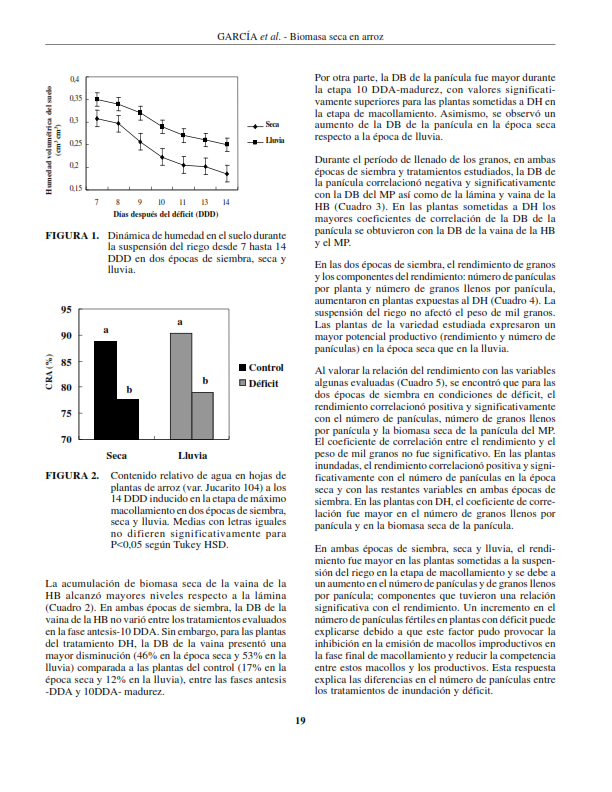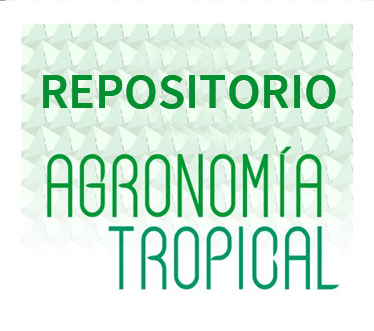Dry mass accumulation of different organs of the rice plant under water deficit conditions
Abstract
The present study evaluated the effect of water deficit at tillering stage on dry biomass accumulation in different organs of rice plants, Oryza sativa L. cv. Jucarito-104, cultivated in two sowing dates, dry and wet seasons. Water deficit imposed at maximum tillering stage was reflected in the relative water content of the leaf and volumetric water content of the soil in comparison to the flooded treatment. From 10 days after anthesis to maturity, high reductions in the biomass duration were obtained in the flag leaf sheath and main stem in plants from water deficit treatment. This stage coincided with the increment of biomass duration of panicles. The results allowed to conclude that under conditions of water deficit, the panicle filling depends essentially from photoassimilate stored in main stem and flag leaf sheath. In the wet season, a high duration of leaf area allowed higher biomass duration of main stem and of the flag leaf sheath than in the dry season. This suggests that the climatic conditions has influence on the partition of photoassimilates to contribute to the yield of the plants under these conditions.
Downloads
References
• Alfonso, R., E. Ramírez y S. Rodríguez. 2001. Inci- dencia del estrés hídrico en la variación de la heredabilidad en sentido ancho en el cultivo del arroz Revista Cubana del Arroz 3(2):46-54.
• Counce, P. A., T. C, Keisling and A. J. Mitchell. 2000. A uniform, objective and adaptative system for expressing rice development. Crop Sci. 40(2):436-443.
• Cruz, J. A. and I. Pérez. 2000. Translocación y partición de 14C fotoasimilados en trigo, variedad Cuba C-204. Agronomía Trop. 50(1):41-58.
• Dorado, M. 2004. Influencia del número de espiguillas sobre la producción de biomasa y la movilización de las reservas del tallo en plantas de arroz (Oryza sativa L.). Tesis de Maestría en Ciencias Biológicas. La Habana. Cuba. Universidad de la Habana, Facultad de Biología, 87 p.
• He H.Y., M. Koike, T. Ishimaru, R. Ohsugi and T. Yamagishi. 2005. Temporal and spatial variations of carbohydrate content in rice leaf sheath and their varietal difference. Plant Production Science 8(5):546-552.
• Hirano, T., Y. Saito, H. Ushimaru and H. Michiyama. 2005. The effect of the amount of nitrogen fertilizer on starch metabolism in leaf sheath of japonica and indica rice varieties during heading period. Plant Production Science 8(2):122-130.
• Hunt, R. 1990. Basic growth analysis. London UNWIN Boston Sydney Wellington, 112 p.
• Ministerio de la Agricultura (MA). Instituto de Suelos. 1995. Nueva Versión de Clasificación Genética de los suelos de Cuba.
• International Rice Research Institute (IRRI). 2002. Standard Evaluation System for Rice. IRRI. Los Baños, Filipina, 56 p.
• Juan, G. R., G. E. Dehogues y K. L Tzenova. 1996. Relación agua-suelo. In: El riego. Editorial Pueblo y Educación, 31-91 p.
• Kato, Y., A. Kamoshita, J. Yamagishi, H., Himoto and J. Abe. 2007. Growth of rice (Oryza sativa L.) cultivars under upland condition with different level of water supply 3. Root system development, soil moisture change and plant water status. Plant Production Science 10(1):3-13.
• Laza, M. R., S. Peng, S. Akita and H. Saka. 2003. Contribution of biomass partitioning and translocation to grain yield under sub- optimum growing conditions in irrigated rice. Plant Production Science 6(1):28-35.
• Lubis, I., T. Shiraiwa, M. Ohnishi, T. Horie and N. Inoue. 2003. Contribution of sinks and sources sinks to yield variations among rice cultivars. Plant Production Science 6(2):119-125.
• Meneses, J. 2000. Determinación de parámetros de diseño y operación del riego por gravedad en el cultivo de la caña de azúcar. Tesis de Maestría en Ciencias en Riego y Drenaje. La Habana, Cuba. Instituto de Investigación del Arroz 51 p.
• Nagata, K., S. Yoshinaga, J. Takanashi and T. Terao. 2001. Effects of dry matter production of non structural carbohydrates and nitrogen application on grain filling in rice cultivar Takanari, a cultivar bearing a large number of spikelets. Plant Production Science 4(3):173-183.
• Okawa, S., A. Makino and T. Mae. 2003. Effect of irradiance on the partitioning of assimilated carbon during the early phase of grain filling in rice. Annals of Botany 92(3):357-364.
• Pirdashti, Z. H., T. Sarvestani, G. H. Nematzadeh and A. Ismail. 2004. Study of water stress in different growth stages on yield and yield components of different rice (Oryza sativa L.) cultivars. In: Proceeding of the 4th International Crop Science Congress. Australia 26 Sep-1Oct 2004. ISBN 1920842209.
• Pham, D., M. Hirano, S. Sagawa and E. Kuroda. 2004. Varietal differences in tillering and yield response of rice plants to nitrogen - free basal dressing accompanied with sparse planting density in the Tohoku region of Japan. Plant Production Science 7(1):3-10.
• Polón, R. and R. Castro. 1999. Aplicación del estrés hídrico como alternativa para incrementar el rendimiento en el cultivo del arroz (Oryza sativa L.) Cultivos Tropicales 20(3):37-39.
• Polón, R. Y. Parra, R. I. Castro y R. Morejón. 2001. Diferentes momentos de establecimiento del inundación permanente en el cultivo del arroz (Oryza sativa L.) y su influencia sobre el rendimiento, sus componentes y el control de malezas. Cultivos Tropicales 22(1):53-55.
• Sánchez-Díaz, M. y J. Aguirreolea. 2001. Relaciones Hídricas. In: Fisiología y Bioquímica Vegetal. Ed. Mundi- España. 17-30 p.
• SPSS. 2003. Programa Estadístico, Versión SPSS 12.0 Inc, Chicago, Il, USA
• Statgraphics. 2000. STATGRAPHICS Plus sobre Windows versión 5.0. Copyright 1994-2000. Statistical Graphics Corporation.
• Tarjuelo, J. M. 1995. El agua en el suelo. In: El riego por aspersión y su tecnología. Eds. Mundi-Prensa, 17-37 p.





